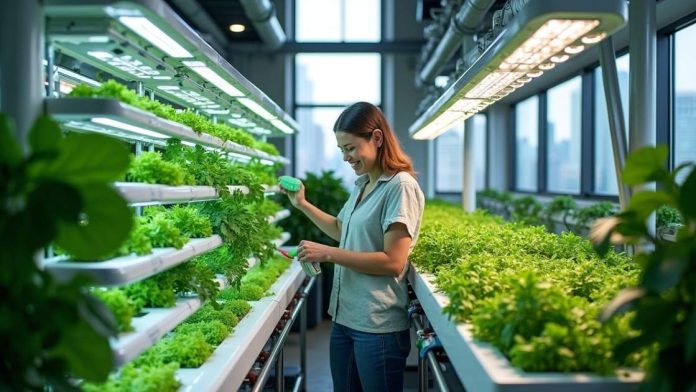rows of lush green lettuce, basil, and tomatoes growing—not in soil—but in a vertical garden powered by nutrient-rich water. Next to them, fish swim peacefully in tanks, helping nourish those very plants. Sounds like science fiction? Welcome to the world of hydroponics and aquaponics—two sustainable farming innovations that are transforming how we grow food.
With the global population rising and arable land shrinking, traditional farming methods are facing serious limitations. That’s where soil-less agriculture comes into play. These techniques not only conserve space and water, but they also promise fresher food, grown locally and sustainably—even in urban apartments or arid deserts.
What is Hydroponics? Watering Your Way to a Greener Future
Hydroponics is the art and science of growing plants without soil, using a water-based solution rich in nutrients. Instead of drawing minerals from the earth, the plants get their food directly from water infused with everything they need to grow.
Common Hydroponic Systems Include:
-
Nutrient Film Technique (NFT): A thin film of water continuously flows over the plant roots.
-
Deep Water Culture (DWC): Plants are suspended in oxygenated, nutrient-rich water.
-
Ebb and Flow: Water periodically floods and drains from the root zone.
Why it’s gaining traction:
-
Uses up to 90% less water than traditional agriculture.
-
Speeds up plant growth and increases yields.
-
Can be done indoors, vertically, and year-round.
Motivational Tip: You don’t need a backyard or a green thumb. Even a small hydroponic herb garden on your windowsill can spark your journey toward self-sufficiency.
What is Aquaponics? The Ultimate Symbiotic System
Aquaponics combines hydroponics with aquaculture (fish farming). Think of it as a living ecosystem: fish waste provides nutrients for plants, and plants purify the water for the fish. No synthetic fertilizers. No waste.
Here’s How It Works:
-
Fish produce ammonia-rich waste.
-
Beneficial bacteria convert ammonia into nitrates—natural plant food.
-
Plants absorb the nitrates, cleaning the water.
-
Clean water returns to the fish tank.
Popular Fish Used:
-
Tilapia
-
Catfish
-
Trout
-
Koi
Why it’s a game-changer:
-
Dual production: fresh vegetables and fish.
-
Environmentally friendly and highly efficient.
-
Almost zero waste—water is continuously recycled.
Motivational Insight: Aquaponics brings nature’s balance into your backyard. It’s more than farming—it’s eco-harmony in action.
Hydroponics vs. Aquaponics: What’s Right for You?
| Feature | Hydroponics | Aquaponics |
|---|---|---|
| Nutrient Source | Synthetic nutrient solution | Natural fish waste |
| Startup Cost | Moderate | Higher (due to fish and tanks) |
| Maintenance | Lower | Higher (monitoring fish health) |
| Growth Speed | Slightly faster | Slower, but more sustainable |
| Yield Type | Only plants | Plants and fish |
Pro Tip: If you’re new to indoor farming, start with hydroponics. Once you’re comfortable, graduate to aquaponics for a richer, more rewarding experience.
How to Start Your Own System at Home
1. Pick Your Method
-
Hydroponics: Easier for beginners.
-
Aquaponics: More complex but sustainable long-term.
2. Choose Your Setup
-
Vertical towers, floating rafts, or stacked containers work well in small spaces.
3. Select Crops and Fish
-
Best hydroponic plants: Lettuce, spinach, herbs, strawberries.
-
Best aquaponic plants: Leafy greens, peppers, tomatoes.
-
Common fish: Tilapia, goldfish, or koi for beginners.
4. Monitor & Maintain
-
Watch pH, nutrient levels, water temperature, and light exposure.
-
For aquaponics, ensure fish health with proper feeding and oxygenation.
Real-World Success Stories: Small Systems, Big Impact
-
Urban farms in New York and Tokyo are using hydroponics to grow fresh produce in high-rise buildings.
-
Schools across the U.S. are incorporating aquaponics to teach biology and sustainability.
-
In Kenya, farmers are adopting small-scale hydroponic greenhouses to combat drought and food insecurity.
These aren’t just systems—they’re solutions.
FAQs
Q1: Is hydroponics organic?
A: Technically, hydroponics is not considered organic under USDA standards unless natural inputs are used. However, many systems use eco-friendly, non-toxic nutrients.
Q2: Do aquaponics systems smell bad?
A: Not if maintained properly! Clean systems have little to no odor, thanks to the plants acting as natural filters.
Q3: How much time does maintenance take?
A: Around 10–20 minutes daily for home systems. Most of it is spent checking water pH, feeding fish (in aquaponics), and trimming plants.
Q4: Can I grow root vegetables in these systems?
A: Leafy greens and herbs do best, but with the right setup, you can grow carrots, beets, and even potatoes.
Q5: Is it cost-effective?
A: Initial costs can be higher than soil gardening, but long-term savings on water, space, and pesticides make it worthwhile.
Conclusion
Hydroponics and aquaponics aren’t just futuristic fads—they’re the present and future of sustainable farming. They empower anyone—from apartment dwellers to educators to global farmers—to take control of their food source, reduce waste, and reconnect with nature.
What starts with a single lettuce plant or a tank of tilapia can blossom into a new way of life—one rooted in innovation, sustainability, and self-reliance.
🚀 Ready to grow beyond limits? Start small, stay curious, and don’t be afraid to experiment.
🌱 Now, it’s your turn! Have you tried hydroponics or aquaponics? Or maybe you’re planning to?
More importantly—how do you manage your time when taking on projects like this? Share your time-saving tips, weekend gardening hacks, or project management tricks in the comments below. Your ideas could help others grow too!

